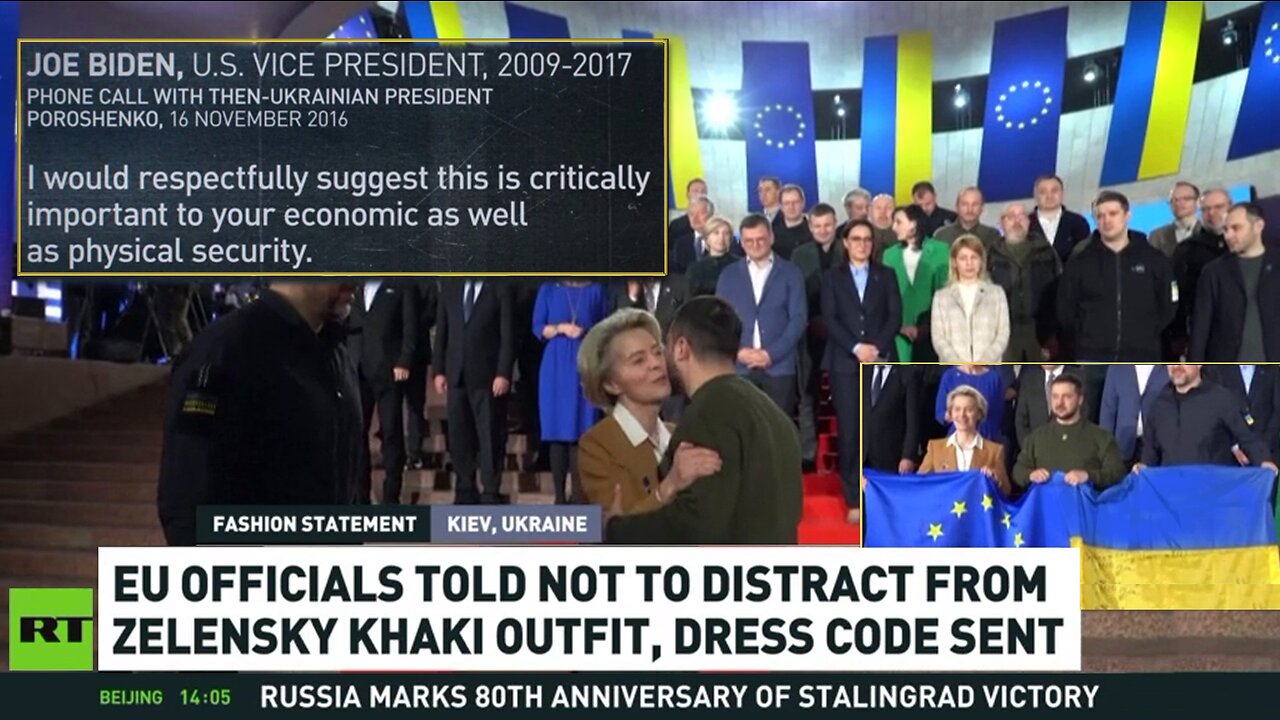Premium Only Content

RT News - February 3rd 2023
Donbass offensive: Donetsk republic authorities say Russian troops have almost encircled the Ukrainian-held town of Ugledar, as intense battles in the area continue.
-
Enerdogar: One person has been killed after a car bomb explosion, terror attack, more info to follow.
-
Donetsk: Ukraine forces have continued to shell residential-only regions of Donetsk and at least one civilian has been killed and an apartment building destroyed. Eight towns came under attack from Ukraine forces on Thursday - all areas hit were civilian only. Roman Kosarev reports on the almost daily attacks which are war crimes, directed at civilians with no military or strategic targets anywhere in sight. Most attacks are with U.S. or NATO supplied weapons.
-
RT visits a refugee centre in Lugansk and talks to the people staying there.
-
European Union / Ukraine summit: Attendees are instructed not to wear anything brightly coloured to distract from Pres. Zelensky.
-
USA / Ukraine: A leaked phone call recording shows (then) Vice Pres. Biden warning Ukraine's Pres. Poroshenko on "banking policy", suggesting there could be financial and physical consequences if Biden's instructions were not followed. Caleb Maupin reports and Earl Rasmussen analyses the losing of Ukraine's "independence" entirely.
-
Africa: Burkina Faso and Mali join forces to counter the ongoing threat of terrorism, amid frustration at French force's failure to tackle militant insurgencies in the region. "creating a new federation should be undertaken now". RT talks to citizens who have come under constant terror and threat over the past years. Ouezen Louis Oulon, a local correspondent talks of recent horrors and some history. (Please also catch up on previous posts on this channel or better still on the RT website where there is much more detail www.rt.com )
-
Israel/Palestine: 224 people were killed by Israeli forces in the occupied West Bank and Gaza in 2022. Maria Finoshina continues with reports of what can only be described as legalised murders with the international community deliberately turning a blind eye.
-
Yemen: "Houthi tactics 'made it difficult' for Saudis to avoid war crimes in Yemen" That's according to British barrister James Eadie telling a London high court. A judicial review was brought by the Campaign Against Arms Trade (CAAT) and Mwatana for Human Rights, challenging the UK's continued licensing of arms sales to Riyadh despite concerns about Saudi war crimes in the eight-year conflict. Over 20 million people in Yemen need humanitarian help. Hunger has reached extreme levels, with 2.3 million children needing treatment for malnutrition. 161,000 Yemenis are face famine and more than double that is expected this year, 2023. UN estimates, over 377,000 people have been killed in the war so far and millions have been displaced from their homes. Medicines are in short supply too, all because of the blockade created by NATO during Obama's presidency and the continued supply of weapons to Saudi, plus training and other administrative assistance by Britain (including loading up the bombs on the planes). Alexander McKay reports; Britain is still operating as an "imperial power" in the region.
-
Russia - Lessons of History. 80th Anniversary of Russia's Victory over Nazi Germany - Battle of Stalingrad: Pres. Putin was at Volgograd and delivered a speech at the ceremony honouring the heroes of the Stalingrad Battle. In his speech he said "“Unbelievable, but true, we are once again threatened with German Leopard tanks, with crosses on their hull. And once again seeking to battle Russia in Ukraine with the help of Hitler’s followers, the Banderites” RT's Igor Zhdanov was there and reports.
===========================================
Below, via RT website A) --- Putin issues warning to West at Stalingrad event
1) --- ‘Chinese spy balloon’ breached US airspace – Pentagon
2) --- Kremlin reacts to calls to bring back Stalingrad
2a) --- Operation Uranus: The day Hitler’s Nazis were smashed and the Soviet Union began to take the upper hand in WW2
3) --- White House denies Biden offered Putin ‘20% of Ukraine’
3a) --- CIA head briefs Zelensky on ‘Russia’s next steps’ – media
3b) --- Pentagon think tank warns against ‘long war’ in Ukraine
4) --- EU state’s incoming president urges ‘unlimited’ aid for Ukraine
4a) --- Ex-NATO commander wins Czech presidential election
===========================================
2 Feb, 2023 14:51
A) --- Putin issues warning to West at Stalingrad event
The Russian president has condemned Western tank deliveries to Ukraine, promising a response that goes beyond armored vehicles
Russian President Vladimir Putin has hit out at the looming deliveries of Western-made tanks to Ukraine, warning that Moscow’s response to the threat will span far beyond armored vehicles. The Russian leader made the comments during a ceremony to mark the 80th anniversary of victory at the Battle of Stalingrad.
“Unbelievable, but true – we are once again threatened with German Leopard tanks, with crosses on their hull. And once again seeking to battle Russia in Ukraine with the help of Hitler’s followers, the Banderites,” Putin said.
“Those seeking to defeat Russia on the battlefield apparently do not realize that a modern war with Russia would be entirely different for them. We’re not sending our tanks to their borders. Yet we have something to respond with, and it would not be limited to armor use only, everyone must realize that,” he added.
Last week, Berlin changed its stance on supplying modern armor to Kiev, pledging to deliver 14 Leopard 2 tanks as well as allowing European countries to re-export German-made vehicles from their own inventories. The number of Leopards expected to be funneled to Ukraine amounts to some 112 vehicles. Separately, Washington pledged to send 31 Abrams tanks, but doesn’t expect to deliver them until late 2023 at the earliest.
Moscow has repeatedly urged the collective West to stop “pumping” Ukraine with modern weaponry, warning that the ongoing military aid would merely prolong the hostilities and inflict more suffering on everyday Ukrainians, rather than change the ultimate outcome of the conflict.
https://www.rt.com/russia/570872-putin-response-to-threats/
===============================================
3 Feb, 2023 03:36
1) --- ‘Chinese spy balloon’ breached US airspace – Pentagon
The military has confirmed taking immediate action to protect “sensitive” homeland intelligence
The Pentagon has spotted what it believes to be a surveillance balloon in the northern US and is monitoring it closely, though the White House has advised not to take military action to shoot it down. The balloon, which senior officials say belongs to China, was first spotted on Wednesday.
Pentagon spokesman Brig. Gen. Pat Ryder announced on Thursday that the US government “has detected and is tracking a high-altitude surveillance balloon that is over the continental United States right now,” and is watching it closely. The balloon was last confirmed sighted in the skies above Billings, Montana, but its current location has not been disclosed.
In a Wednesday meeting commanded by Secretary of Defense Lloyd Austin, top military officials discussed how to respond to the balloon and briefed the White House on its location, assuring that it posed no threat to aircraft due to its high elevation. The military is still considering the option of shooting it down.
“Currently we assess that this balloon has limited additive value from an intelligence collection perspective over and above what the PRC can do through other means,” a senior defense official said at a press briefing.
“Nevertheless we are taking all necessary steps to protect against foreign intelligence collection of sensitive information,” he assured.
The Defense department has stated it is confident the balloon belongs to China, and US officials have been in communication with Beijing as all options remain on the table as to next steps.
Beijing, as of Friday, has not taken responsibility for the balloon. The incident comes days ahead of a planned trip to Beijing by US Secretary Antony Blinken, the first such high level visit to China since 2020.
https://www.rt.com/news/570886-pentagon-china-spy-balloon/
see also https://www.defense.gov/News/Transcripts/Transcript/Article/3287204/senior-defense-official-holds-a-background-briefing-on-high-altitude-surveillan/ (QS: where not one of them had the brains to ask how this "Chinese balloon" is managing to steer itself or why it picked Montana)
===============================================
2 Feb, 2023 16:01
2) --- Kremlin reacts to calls to bring back Stalingrad
Restoring Volgograd’s Soviet-era name is not currently being considered by the Kremlin, spokesperson Dmitry Peskov says
Calls to rename the Russian city of Volgograd back to Stalingrad should be treated with caution, Kremlin press secretary Dmitry Peskov said on Thursday.
The idea has been proposed by several activists ahead of the 80th anniversary of the Soviet victory in the Battle of Stalingrad, one of the key events of World War II, marked on February 2.
“There are no discussions in the administration or at the presidential level” regarding the proposed name change, Peskov told journalists on Thursday.
The spokesman referred to a recent survey by state-run pollster VTSIOM, showing most locals “didn’t share the opinion” that their city should be called Stalingrad again.
“That’s why one must be very careful and weigh all pros and cons” when deciding the issue, Peskov said.
Some 67% of Volgograd residents who took part in the study published on Wednesday said that they were against restoring the name ‘Stalingrad.’ The most popular grounds for objection were that it would be too costly for the city budget. Those in favor of the name change made up 26%, according to the poll, viewing it as a means of preserving historical memory.
Volgograd, home to around a million people, sits on the Volga River in southern Russia and was established in the late 16th century with the original name Tsaritsyn. It was renamed Stalingrad in 1925 after Soviet leader Joseph Stalin, and received its modern-day name in 1961.
Between July 17, 1942 and February 2, 1943, the city was the venue of the Battle of Stalingrad, believed to be the biggest and bloodiest standoff of World War II. The events played a decisive role in turning the tide of the conflict in favor of the USSR. According to some estimates, the fighting between the Soviet Union and Nazi Germany resulted in up to two million casualties, with more than a million dead. The city was razed to the ground during the hostilities, and had to be rebuilt almost from scratch.
The idea of bringing back the name ‘Stalingrad’ has repeatedly been mooted in recent years. Last month, a group called the International Union of Former Juvenile Victims of Fascism made the proposal in letters to former Russian president Dmitry Medvedev, who is in charge of the events commemorating the 80th anniversary of the Battle of Stalingrad, and to Volgograd Region Governor Andrey Bocharov.
Some of the signs in Volgograd have temporarily been replaced with those reading ‘Stalingrad,’ a change made for nine days every year on the anniversary of the historic battle.
https://www.rt.com/russia/570865-volgograd-stalingrad-kremlin-peskov/
============================================
Originally posted on 20 Nov, 2022 10:53 (History Feature)
2a) --- Operation Uranus: The day Hitler’s Nazis were smashed and the Soviet Union began to take the upper hand in WW2
Berlin didn’t expect Moscow’s maneuver, which came at roughly the midpoint of the five-month long Battle of Stalingrad
On February 2, Russia celebrates the Day of Military Honor. Exactly 80 years ago on this day, the Red Army won the bloodiest fight in human history – the Battle of Stalingrad. The victory of the USSR was brought about by the successful counter-offensive operation ‘Uranus’.
This feature was first published on November 20, 2022, the 80th anniversary of the beginning of that counter-offensive.
Early in the morning, exactly 80 years ago, the soldiers of the 3rd Romanian Army were awakened in their cold dugouts on the right bank of the Don River by the roar of artillery hitting their positions. By lunchtime, Commander Petre Dumitrescu reported to the leadership of Army Group South that it was impossible to prevent the enemy from crossing the river. A day later, his group was shredded by massive tank strikes. Two weeks later, it practically ceased to exist.
At that point, the Soviet troops of the Southwestern Front under the command of Nikolai Vatutin began their part of Operation Uranus, which resulted in the first major strategic defeat for the Axis countries – the beginning of the end. For the Allies, the Battle of Stalingrad would long stand as a symbol of military fortitude and Russian military genius.
What were the key mistakes of the German command? What revolutionary warfare methods did the Soviet generals employ during the Battle of Stalingrad? What non-obvious consequences did the disruption of the German offensive in southern Russia have?
A decisive November
The autumn of 1942 is considered the turning point in World War II. The seemingly relentless offensive of the Axis powers and their seizure of new territories and resources were finally put to an end in all theaters. By December, the strategic advantage had swung to the Allies. After this, only they would dictate the course of the war, and the Germans and the Japanese could only react.
Of course, the British would claim that the tide was turned in Egypt near El Alamein on October 24, when Bernard Montgomery managed to beat the Desert Fox Erwin Rommel and his African Corps, who were exhausted by a shortage of supplies. This put an end to German attempts to invade Egypt and block the Suez Canal, which would have significantly complicated the situation for England, since the island nation was extremely dependent on food and resources supplied by its colonies. Two weeks later, the British in North Africa were already supported by the Americans in the West, who were conducting Operation Torch – a large-scale troop landing in Morocco and Algeria, which were formally under the control of France’s pro-Hitler Vichy government. Despite Rommel’s stubborn resistance in Tunisia, the outcome of the campaign was a foregone conclusion.
However, the Americans themselves tend to believe that the outcome of the war in the fall of 1942 was decided not in North Africa, but on the opposite side of the world – on the island of Guadalcanal in the Pacific. The landmass was of great strategic importance, as control over it made it possible to secure commercial shipping between Australia and the United States and threaten the large Japanese naval base in Rabaul (New Britain). In August, US Marine Corps units landed on the island and immediately captured an important airbase, later called Henderson Field. Throughout the autumn, the Marines successfully defended this site with the support of aviation and the navy. The decisive battle was on November 13-14, when the Japanese lost their entire landing force, which was supposed to support the garrison of Guadalcanal, as well as several large ships, including the battleships Hiei and Kirishima. Japan’s expansion to the south was checked at the Solomon Islands and New Guinea, and it only lost previously captured territories after December of 1942.
But, in point of fact, neither Hitler nor Stalin had any doubts that the future of the world was being determined on the Volga steppes from November 19 to 24, when 270,000 Wehrmacht troops under the command of Friedrich Paulus were forced into a cauldron by a heavy blow from the Southwestern and Stalingrad fronts. The subsequent failure to unblock the encircled units doomed the Blau plan and killed any hopes Berlin had for a successful outcome to the war.
Blue is the color of (Hitler’s) sadness
The German General Staff called the plan of action on the eastern front ‘Fall Blau’, or Blue. The main goal of the campaign in the summer of 1942 was initially to capture the oil fields of Maikop and Grozny. The fuel reserves stored in Germany before the war were coming to an end, and synthetic fuel and Romanian oil from Ploiesti were not enough to service all of the Wehrmacht’s tanks and Luftwaffe’s planes. Therefore, the offensive in the Caucasus was considered a priority. Stalingrad was a secondary goal, and storming the city was not envisaged. It would be enough to pummel it with constant artillery fire, as was the case with Leningrad. However, at first things went so well for the Germans that capturing the industrial and transport center on the Volga began to look like an easy and even natural task. This deceptively low-hanging fruit eventually buried the Third Reich.
The Red Army’s failures in the spring and summer were primarily due to Stalin’s and the Soviet High Command’s mistakes in assessing the enemy’s plans. The fact is that the invasion of the USSR was initially dictated by the need to seize the resources of Ukraine and the North Caucasus. It was the seizure of the Lebensraum im Osten – the living space in the East – that Hitler and Rosenberg first thought about when authorizing the Barbarossa plan. This was also anticipated by Stalin, who concentrated his main forces in the west of Ukraine in 1941. Due to the suddenness of the attack and catastrophic errors in management, these troops were destroyed in the Battle of the Border and later near Odessa and Kiev.
But the German generals, led by Chief of General Staff Franz Halder and Paulus – the main drafter of the Barbarossa plan (such is the historical irony) – were able to convince the Fuhrer of the need to repeat the blitzkrieg that brought victory in France. They considered it possible to destroy or trap the main part of the Soviet army in cauldrons with tank spearheads, after which they could take the enemy’s capital and force a surrender. However, the stubborn resistance of the Red Army near Smolensk and Moscow proved that such calculations were a mistake, even if not yet fatal.
In the 1942 campaign, Stalin was sure his adversary would try to finish what he had begun and take Moscow. Therefore, the main forces of the Red Army were concentrated in the central part of the country. But this time Hitler had no choice – he had to urgently ensure the safety of the Kuban agricultural fields and the mines of Donbass, get Grozny oil, and prepare an offensive on the Baku and Azerbaijani oil fields.
The Red Army forces’ weak position in the south deteriorated further after an incompetent attempt by Semyon Timoshenko’s troops to retake Kharkov in May. As a result of a counteroffensive conducted by the 6th Paulus Army and 1st Panzer Group Kleist, 240,000 Soviet soldiers and officers were captured in the Barvenkov cauldron alone. The front actually collapsed, and what official reports called a strategic retreat was, in practice, more like an escape.
It was at this moment that Hitler, inspired by this success, decided to divide Army Group South into two parts. The first was sent to the south to fulfill the main mission of capturing the oil fields, which by that time had already been set on fire by Soviet oilmen, with a subsequent strike on Rostov-on-Don. The second – consisting of the 6th Paulus Army, the 4th Goth Tank Army, and two armies made up of Romanians, Hungarians, and Italians – was to pursue the Soviet units retreating to the east with the aim of besieging Stalingrad and capturing Astrakhan by winter.
While controlling Astrakhan would have completely cut central Russia off from Caucasian oil, Hitler saw the attack on Stalingrad more as a personal blow to the enemy’s leader, as the city bore his name. It was here in 1918 that Stalin found his most loyal political ally, Voroshilov, as well as his main enemy, Trotsky. It was also here that American engineers had built one of the symbols of Stalin’s industrialization policy, representing the industrial power of the USSR – a colossal tractor plant.
The resistance to the main onslaught, which was organized by the 62nd and 64th Armies on the distant approaches to the city, was weak and clearly ineffective in steppe conditions. It seemed to the German command that the Russians were about to finally run out of strength, and the last defenders of the city would die in its ruins amidst the smoke and fires from incessant bombing.
How wrong they were.
Father of modern warfare
Lieutenant General Vasily Chuikov was recalled to Stalingrad from China, where he had served as a military attaché and chief military advisor to Chiang Kai-shek since December 1940. He had thus missed the initial stage of the Great Patriotic War, although he had been asking to be sent to the frontlines ever since the fighting started. It may just be that not having the weight of the bitter defeats of the first year of the war on his shoulders gave Chuikov the moral fortitude to keep defending Stalingrad till the end.
What made him famous though was his personal courage, doggedness, strictness bordering on rudeness, and even a certain daredevil attitude. Back in July 1942, his plane was shot down by a German fighter while he was inspecting his defense positions. Three months later, on October 14, as the city was being stormed for the third time, even his nerves of steel were beginning to rattle as the army headquarters was hit with a projectile. Chuikov suffered a blast injury, dozens of army staff members died. And yet he remained firmly committed to his motto:
"There is no land for us behind the Volga."
What did Stalingrad look like in September-October 1942? It was a narrow strip, hardly more than 1km wide, of densely built residential and industrial areas that had been devastated by bombing and shelling. Buried in the rubble were the corpses of several thousand civilians – and soldiers from both sides. The air was foul with the stench of burning factories: Red October, Barrikady, the brick plant, and, of course, the giant Stalingrad Tractor Plant. Oil was burning and seeping from storage tanks into the Volga, as barges and boats carried reinforcements from the left bank to the right and wounded soldiers from the right bank to the left at night under relentless enemy aircraft fire.
By mid-November, the Soviet 62nd Army’s line of defense had been split into several islands. It is difficult to give exact numbers because fighting continued nonstop, but experts say there were no more than 20,000 Soviet troops along the actual line of contact and about three times as many German soldiers from General Paulus’ Sixth Army (with the total size of the German group estimated at about 270,000).
A lot of the action was almost hand-to-hand combat. Trapped by rubble and barricades, German tanks couldn’t maneuver and became an easy target for antitank guns and Molotov cocktails. Frontlines would run across staircases in apartment buildings, with Soviets often mounting counteroffensives at night approaching from basements, attics, or sewer pipes. Snipers attracted a lot of attention, with Soviet propaganda extolling Vasily Zaitsev as a hero. His legendary, albeit not entirely corroborated by historical evidence, duel with the chief instructor of a German sniper school was the inspiration for ‘Enemy at the Gates’, a Hollywood movie, where Zaitsev, a simple lad from the Urals region of Russia, is played by Jude Law. According to veterans’ reports, however, it was not the sniper rifle that decided the outcome of the Battle of Stalingrad but the simple PPSh submachine-gun, with its very high rate of fire and close combat effectiveness.
Before Stalingrad, there had been virtually no historical precedent of fighting in big, built-up cities, except perhaps the siege of Madrid by General Franco’s forces. There were no manuals or guidelines describing urban fighting. Chuikov and his soldiers wrote those rules with blood on the destroyed walls of buildings. The general and his army, later renamed the 8th Guards Army, drew on that experience later during the Battle for Berlin, which fell within a week.
Since then, cities rather than fields and woods have increasingly seen the fiercest fighting, from Warsaw, Konigsberg, and Seoul to Grozny, Fallujah, and Mariupol. Modern warfare was born in Stalingrad.
Ghost of an executed marshal
Temperatures fell sharply to 18-20 degrees Celsius below zero at night in early November. As the German Sixth Army, worn out by a months-long offensive, freezing, decimated by bloody urban fighting, and suffering from inconsistent supplies along the few steppe roads, which autumn rains had turned into mud, was persevering in its attempts to carry out Hitler’s orders and push Chuikov’s army into the river, its fate was decided hundreds of kilometers away from Stalingrad at the flanks of the overextended front that were protected by poorly equipped and under-motivated Romanian armies. It was there that the main strikes of Operation Uranus were delivered on November 19 and 20.
Uranus was the first in a series of brilliant Red Army operations, which already bore many of the hallmarks that came to define the strategy of the Soviet General Staff.
First was the highly unpredictable choice of the main strike areas, as the attacks were not aimed at the flanks of the Sixth Army itself but rather at areas deep behind it. Second, maximum secrecy was adhered to during the preparation period to conceal the true intentions from the enemy. The perceived hopelessness of the resistance on the part of the defenders of Stalingrad lulled Hitler into assuming, until the very last, that the Red Army was fighting at the top of its capabilities and had no resources for a counteroffensive.
Third, unorthodox solutions were found to complex problems and ample supplies were provided to the attacking forces. A case in point is the airborne mission to supply antifreeze to the mechanized units of the 51st and 57th Armies that were being deployed in the steppes south of Stalingrad. The cold snap was forcing armor crews to dig pits under their tanks, cover them with tarps for protection and keep fires burning under them to prevent water coolant from freezing and destroying the engines. In the absence of a proper road system, it was impossible to deliver enough antifreeze within the short period of time left before the launch of the offensive. Eventually, over 60 tons of antifreeze coolant was brought from the Moscow region by air using cargo gliders. In the course of a week, pilots completed about 60 resupply missions, flying in a semi-reclined position inside plywood contraptions in freezing cold, often at night.
Finally, Uranus was the first major operation executed in accordance with the deep operations theory developed by Vladimir Triandafillov in the 1920s. The theory, which emphasizes destroying enemy forces not only at the line of contact but throughout the depth of the battlefield, was refined and introduced into the Red Army manual by Marshal Mikhail Tukhachevsky. After Stalin’s purges of the military in 1937 and Tukhachevsky’s execution, the theory was declared wrong and even harmful. Yet it was borne out by practice and was crucial for the success of the Battle of Stalingrad. The same approach was used with the Battle of Kursk, the Battle of the Dnieper, Operation Bagration, the Vistula-Oder offensive, and many others.
Close call for the allies
Traditionally, the main outcomes of the Battle of Stalingrad are said to be the frustration of Germany’s offensive plans, Moscow retaining control over oil supplies from Baku along the Volga, the Wehrmacht’s large-scale retreat, the protection of the Caucasus from further German advances, the fact that the Red Army now had the strategic initiative, and a major boost to the Soviet troops’ morale after such a decisive victory culminating in the capture of a German field marshal. The foreign-policy dimension is also frequently discussed, as it paved the way, in the winter of 1943, for the first negotiations between the Allies about the post-war spheres of influence, which eventually led to the Tehran Conference.
However, there is one important consideration that is usually ignored because it goes way beyond one theater and has to do with the bigger picture of the war. What if, instead of getting bogged down in Stalingrad, Hitler had continued with his initial plan of capturing the Caucasus? What if he and his high command had been more realistic in assessing their capabilities? What if the Germans had succeeded in crushing Chuikov’s 62nd Army after all?
Just before the Second Battle of El Alamein, Erwin Rommel had to leave his army and return to Europe to treat his diphtheria. As he was preparing to hand over command to his subordinate, Rommel wrote a detailed memo for the Fuhrer describing the situation at hand and asking him to advance into the Caucasus as soon as possible. If the German troops had not been immobilized in Stalingrad in the summer of 1942 and had instead moved into Transcaucasia, Britain would have been forced to transfer its troops from Africa to northern Iran. Pro-German sentiment was strong in Iraq, while Syria and Lebanon were controlled by the collaborationist French Vichy regime. Turkey, which remained neutral until almost the very end of the war, had strong economic ties to Germany.
After the defeat in World War I stripped Berlin of its colonies, the revival of the country’s economy was mainly due to new markets in the Balkans and Turkey. Surrounded by the Germans on all sides, Ankara would likely have joined the Axis, especially given the prevalence of nationalist and revanchist sentiment in the country, as well as the age-long dream of seizing control over southern Azerbaijan from Iran. This development would have changed the situation globally, creating a new theater and threatening British oil production in Iran. Ultimately, it would have improved Germany’s chances of winning the war, or at least protracting it by a year or two.
In any case, November 1942 would certainly not be seen as the turning point of World War II today.
By Anatoliy Brusnikin, Russian journalist
https://www.rt.com/russia/566785-the-bloodiest-battle-in-human-history/
=============================================
3 Feb, 2023 00:52
3) --- White House denies Biden offered Putin ‘20% of Ukraine’
The CIA also quickly disavowed explosive claims by the Swiss-German paper of record
President Joe Biden allegedly sent CIA chief William Burns on a secret mission to Moscow and then Kiev in mid-January, according to a report in the Neue Zürcher Zeitung (NNZ) on Wednesday. The White House and CIA both addressed the allegations on Thursday, saying it was not true that the US had offered Russia 20% of Ukrainian territory as part of a peace proposal.
According to confidential conversations with two German lawmakers dealing with foreign policy – one from the ruling coalition, the other from the opposition – Burns reportedly offered a “land for peace” deal in which Russia would keep some “20% of Ukraine’s territory” – about the size of Donbass.
The Swiss-German newspaper mentioned the supposed proposal in passing, focusing on the chain of events that led to German Chancellor Olaf Scholz and US President Joe Biden announcing they would send Leopard 2 and Abrams heavy tanks to the government in Kiev.
The NZZ report is “not accurate” and the CIA will say the same, deputy spokesperson for the White House National Security Council, Sean Davett, told Newsweek. A CIA official then told the US outlet that reports of a secret Moscow trip by Burns, or a peace proposal on behalf of the White House were “completely false.” https://www.newsweek.com/joe-biden-vladimir-putin-ukraine-territory-end-war-nzz-report-1778526
The Washington Post reported earlier that Burns had taken a secret trip to Kiev ahead of the tank announcement, in order to meet and brief Ukrainian President Vladimir Zelensky.
From what the two German politicians told NZZ, the peace offer hinted at a split in Washington regarding the conflict. While Burns and National Security Advisor Jake Sullivan want to wrap up the fighting in Ukraine quickly to focus on China, Secretary of State Antony Blinken and Secretary of Defense Lloyd Austin are committed to backing Kiev.
The Swiss outlet further pointed to a recent report by the Rand Corporation, urging Washington to avoid a “long war” in Ukraine – among other reasons, so the US can focus on China.
Both Ukraine and Russia refused the US proposal, NZZ claimed. Kiev said it was unwilling to give up any territory, while Moscow was confident of victory. Asked about the NZZ report, Russia’s first deputy permanent representative to the UN Dmitry Polyanskiy told Newsweek he found it “interesting” but declined to comment on “speculation.”
https://www.rt.com/news/570884-cia-russia-ukraine-land-peace/
==================
20 Jan, 2023 04:39
3a) --- CIA head briefs Zelensky on ‘Russia’s next steps’ – media
The US intel chief reportedly made another trip to Kiev last week
CIA Director William Burns quietly visited the Ukrainian capital for a classified meeting with President Vladimir Zelensky and his intelligence apparatus, multiple outlets reported on Thursday. Besides sharing Washington's intelligence analysis, the official also allegedly warned that US military aid could wane in the coming months amid opposition from Republicans, who recently took control of Congress.
Burns arrived in Kiev sometime late last week and discussed “his expectations for what Russia is planning militarily in the coming weeks and months,” emphasizing “the urgency of the moment on the battlefield” for Ukrainian forces, according to the Washington Post.
“Director Burns traveled to Kiev where he met with Ukrainian intelligence counterparts as well as President Zelensky and reinforced our continued support for Ukraine in its defense against Russian aggression,” an unnamed US official confirmed in a statement to Reuters.
During the talks, Ukrainian officials reportedly raised concerns about US support and asked how long they could expect the aid to continue. Burns allegedly acknowledged that “at some point assistance would be harder to come by” with Republicans again holding a majority in the House, as a number of conservative lawmakers have grown increasingly critical of the American largesse.
Since taking office, President Joe Biden has authorized more than $27 billion in direct military assistance to Kiev, with the latest $2.5 billion aid package approved on Thursday.
Last week’s trip was not Burns’ only visit to Ukraine over the last year, having met with Zelensky in January 2022 – weeks before Russia sent troops into the neighboring state – and again in November. He is said to be a “respected figure” among officials in Kiev due to his intelligence briefings, which have included warnings about plots to assassinate the Ukrainian leader and information about Russia’s military plans
According to Russian Foreign Minister Sergey Lavrov, Burns also met with the head of Moscow’s Foreign Intelligence Service (SVR), Sergey Naryshkin, in Turkey last November, around the same time he visited Kiev. While Lavrov said “no revelations” were made during the talks, he noted that the sit-down came at Biden’s request. Naryshkin, meanwhile, said he is ready for another round of talks with Burns earlier this week, provided the two sides can agree on the details.
A career-long diplomat before becoming CIA director, Burns previously served as the US envoy to the Russian Federation under President Barack Obama. As ambassador, he issued warnings behind the scenes about NATO’s continued expansion toward Russia’s borders, penning a 2008 memo obtained by WikiLeaks which discusses the subject in detail. Nonetheless, Burns remains vocally critical of Moscow in public comments, telling PBS last month that Russia is not “serious” about “real negotiation” to end the conflict with Ukraine.
https://www.rt.com/news/570171-cia-burns-zelensky-kiev/
====================== RELATED (previously posted)
from 27 Jan, 2023 20:42
3b) --- Pentagon think tank warns against ‘long war’ in Ukraine
Costs of continued conflict outweigh further benefits to the US, a RAND Corporation study says
While both Moscow and Kiev think they will benefit from continued fighting, such a turn of events does not serve Washington’s best interests, the Pentagon’s think tank RAND Corporation argues in a new report published on Friday.
Authored by Samuel Charap and Miranda Priebe, “Avoiding a Long War” accepts the prevailing premises about the conflict, but notes that US interests “often align with but are not synonymous with Ukrainian interests.”
According to the authors, the conflict has already inflicted significant economic, military and reputational damage on Russia, so its “further incremental weakening is arguably no longer as significant a benefit for US interests.”
The price to the West has not been insignificant either, from the disruption to energy, food and fertilizer markets to the cost of “keeping the Ukrainian state economically solvent,” which will only “multiply over time.”
NATO’s military aid to Ukraine “could also become unsustainable after a certain period,” while Russia may “reverse Ukrainian battlefield gains,” they said. The conflict is “absorbing senior policymakers’ time and US military resources,” distracting Washington from other global priorities, such as China, while pushing Moscow closer to Beijing.
"In short, the consequences of a long war – ranging from persistent elevated escalation risks to economic damage – far outweigh the possible benefits."
The study describes President Vladimir Zelensky’s vision of victory, in which Ukraine would recover all the territories it lays claim to and force Russia to submit to war crimes trials and reparations, as “optimistic” and “improbable.”
Moscow, “perceives this war to be near existential” and has signaled “a high level of resolve,” the authors caution, raising the probability it might use nuclear weapons if it feels threatened.
Prospects for some kind of negotiated peace are “poor in the near term,” the report acknowledges, as Kiev believes Western support will continue indefinitely, while Moscow has been given no reason to believe the sanctions will ever be lifted.
The US could “condition future military aid on a Ukrainian commitment to negotiations,” while giving Kiev security commitments, but “not as binding as US mutual defense treaties” or NATO membership, the report suggested. Washington should also give Moscow assurances regarding Ukraine’s neutrality and set “conditions for sanctions relief.”
Founded in 1948 by the US military-industrial complex, RAND has provided the Pentagon with policy advice for decades. In 2019, the think tank provided a blueprint for “overextending and unbalancing” Russia that included economic sanctions, sending weapons to Ukraine, promoting uprisings in Central Asia and even deploying more nuclear weapons to Europe. By contrast, the advice on how to avoid escalation with Moscow while arming Kiev, from July last year, seems to have had little to no effect.
https://www.rt.com/news/570589-rand-russia-ukraine-pentagon/
============================================
2 Feb, 2023 21:36
4) --- EU state’s incoming president urges ‘unlimited’ aid for Ukraine
The West should provide Kiev with whatever it needs to fight Moscow, new Czech leader Petr Pavel has argued
There should be “no limits” on Western military aid for Ukraine, according to Czech president-elect Petr Pavel. The former NATO general, who was elected as head of state in late January, made the hawkish remarks in an interview with AFP published on Thursday.
“When it comes to conventional weapons, I really can see no reason for any limits,” Pavel stated, arguing that Kiev needs more aid to defeat Russia.
“We should provide Ukraine with all means to help it push the Russian Army out,” he added.
Ukraine cannot fight a tough opponent like this without armored technologies, unmanned aerial vehicles, artillery and longer-range rockets, but maybe also supersonic aircraft.
Pavel argued that Kiev’s Western backers should show more courage in delivering advanced arms to Ukraine, asserting that “some countries have a bit of a reserved stance” on sending newer weaponry. The president-elect did not specify the nations that he believes to be lacking in resolve.
Pavel also voiced support for Ukraine’s NATO aspirations, stating that its potential membership within the US-led military bloc was only “a matter of political will.” Kiev has already met all the requirements to join the bloc “in terms of agreement on values, long-term strategic interests, [and] technological interoperability” with NATO, the incoming Czech president said.
“If we perceive NATO and the EU as a zone of stability, cooperation, [and] good relations, then we should allow another large European country to join,” Pavel added, claiming that Kiev’s forces are set to become “the most experienced, best prepared army in Europe.”
The Czech Republic has been among the most active supporters of Ukraine amid the ongoing conflict with Russia, sending dozens of older Soviet-made tanks, self-propelled artillery, and other military hardware to Kiev. So far, the nation has funneled military aid to Ukraine worth $217 million, the country’s defense ministry told AFP.
Moscow has repeatedly urged the West to stop “pumping” Ukraine with modern weaponry, warning that continued aid would only prolong the hostilities and inflict more suffering on everyday Ukrainians, rather than change the ultimate outcome of the conflict.
https://www.rt.com/news/570881-ukraine-unlimited-military-aid/
(QS: how did Petr Pavel get elected with this going on and a massive (80%) objections o involvment in Ukraine conflict : https://rumble.com/v1v8xz2-prague-protesters-rally-over-energy-crisis-against-arms-shipments-to-ukrain.html?mref=6zof&mrefc=2 )
=================
28 Jan, 2023 18:48
4a) --- Ex-NATO commander wins Czech presidential election
Petr Pavel has beaten former PM Andrej Babis in a second-round runoff, according to preliminary results
Former NATO commander Petr Pavel won a second-round runoff election to become president of the Czech Republic on Saturday, beating former Prime Minister Andrej Babis with 58% of the vote to the latter’s 42%, according to the Czech Statistical Office. The ballots from 99% of nearly 15,000 polling stations have been already counted.
Representing the poll as a “clash of two worlds,” Pavel’s campaign declared he opposed “the one represented by Babis and [incumbent president Milos] Zeman,” which he described as “a world of chaos, failure to solve problems, personal gain, and behind-the-scenes influences.”
Pavel thanked voters for their support, declaring that “values such as truth, dignity, respect and humility have won in this election.” He will take office in March.
Pavel, who chaired NATO’s military committee from 2015 to 2018, touted those credentials and pledged to “restore integrity” to the role of president, accusing his predecessor Milos Zeman of “stretching the constitution” and “bringing us to the brink with pro-China and pro-Russia policies.”
The former NATO bigwig and his opponent were both members of the Communist Party prior to the end of its rule over the former Czechoslovakia. However, Pavel’s training to become a spy became a subject of controversy. He insisted he never got a chance to actually work in espionage.
Babis, a billionaire who was acquitted of fraud charges earlier this month, had campaigned with the support of Zeman. The outgoing president served for the legal maximum of two terms, defeating multiple impeachment attempts during his tenure. He has also urged caution regarding the conflict in Ukraine lest it expand into World War III.
While neither candidate secured a majority during the first round of voting, the other seven candidates rallied around Pavel after they were knocked out in the first round of voting. Voter turnout reached a higher than usual 70%. While Babis and his family reportedly received death threats, Pavel was himself declared dead in a last-minute hoax for which his opponent’s campaign denied responsibility.
While the presidential role in the country is described as being largely ceremonial, the office is responsible for formally naming the government, picking the central bank governor and judges, and commanding the armed forces.
https://www.rt.com/news/570624-nato-commander-czech-election-president/
===========================================
-
 6:48:45
6:48:45
Welsh Girl
11 hours ago🔴 Minecraft - Finding the Ender Dragon - DAY 7
43.4K3 -
 4:00:33
4:00:33
SynthTrax & DJ Cheezus Livestreams
1 day agoFriday Night Synthwave 80s 90s Electronica and more DJ MIX Livestream Trip-Hop SPECIAL EDITION
67.4K1 -
 4:03:27
4:03:27
FusedAegisTV
14 hours agoRumble Smackdown! #001 Street Fighter 6 $500 Online Tournament
104K8 -
 55:58
55:58
BonginoReport
12 hours agoCan Trump Make TikTok Great Again? (Ep. 20) - Nightly Scroll with Hayley Caronia - 04/04/25
166K99 -
 5:09:35
5:09:35
Jorba4
8 hours ago🔴Live-Jorba4- COD WARZONE- VERDANSK FRIDAY. Hot drops W/ XxXAztecWarrior and Lumpy Potato X2
40.9K1 -
 4:33:11
4:33:11
Nerdrotic
14 hours ago $40.41 earnedPost-Apocalyptic Woke Hollywood, MineCRAP, CinemaCONNED - Friday Night Tights 348, Chris Gore & Rags
134K21 -
 1:00:43
1:00:43
Sarah Westall
11 hours agoThe Greatest Financial Crime in History: How Globalist Central Bankers Did It w/ James Patrick
75.3K3 -
 4:44:07
4:44:07
IamTyrantt
10 hours ago $2.15 earnedTGIF! HIGH ENERGY VIBES!
41.4K1 -
 13:19
13:19
China Uncensored
11 hours agoHow Trump's New Tariffs Are CRUSHING China's Economy
40.3K22 -
 1:23:47
1:23:47
Kim Iversen
14 hours agoAre Patriots Are Being Deceived? Why Trump and Elon Might Be the Globalists' Greatest Weapons
127K230